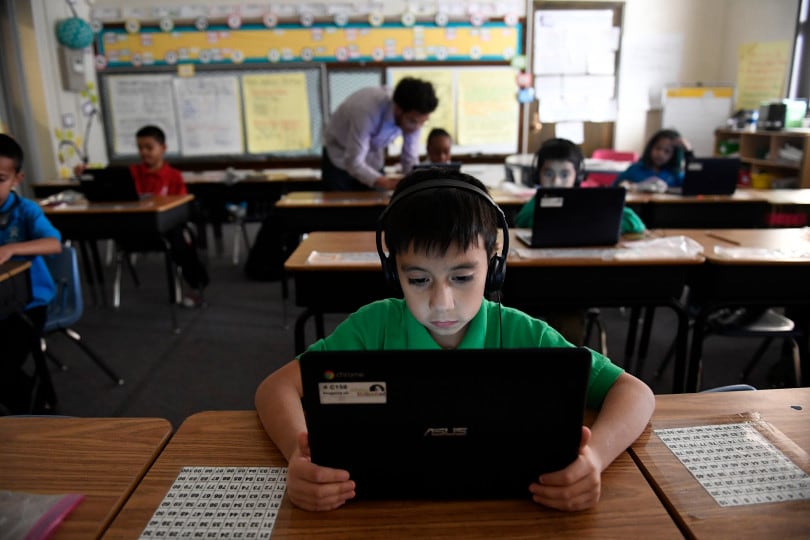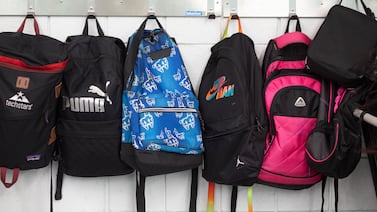Public health officials say it’s inevitable that cases of COVID-19 will turn up in Colorado schools as the school year starts. But as they do, officials stress the use of cohorts as a key way to prevent uncontrolled outbreaks.
Cohorts are groups of students and staff within a school building who interact mostly only with each other. The goal is to limit the number of people anyone is exposed to. As schools try to create smaller cohorts, they have to get creative with new schedules and alternating days.
“It really is one of the most important tools we have,” said Therese Pilonetti, the institutions unit manager for the Colorado Department of Public Health and Environment.
But health officials have left many details of how to create these groups, and how to keep them separate, up to each school district. And teachers and parents have a lot of questions about the logistics of using cohorts to keep students and staff safe whenever in-person classes resume.
The Denver school district cited the inability to create small enough cohorts as one of the reasons it decided to start the semester online. Denver’s draft plans had indicated 60-student cohorts in elementary school and up to 120-student cohorts in high schools. The Aurora school district is planning to cap cohorts at 30 students — a number that some school board members and teachers said still seemed too high.
Here, we’ve answered some questions to help you understand the cohort model better.
What is a cohort and what is the goal of using this model?
A cohort is a group of people — including students and adults — that interact with one another during the school day. The goal of creating and isolating cohorts is that when someone tests positive for COVID-19, fewer people will have been exposed to that person and fewer people in the school will have to quarantine.
“This is a really important strategy in reducing disease transmission and it also really helps limit disruptions to schools,” said Alexis Burakoff, a medical epidemiologist with the Colorado Department of Public Health.
Burakoff said that there’s already evidence of cohort grouping doing its job in other locations. One child care center, which she said she could not name, was able to prevent an outbreak after a person tested positive for COVID-19 because it kept the number of exposures low.
So are classes and cohorts the same thing?
Not necessarily. In elementary school, this could be the case if one teacher stays with one group of students all day. But in middle and high schools, one cohort could be a larger group of students from multiple classrooms sharing a teacher, or other staff.
In some small schools, a cohort might be an entire grade level of students.
In Aurora’s in person plans, high school cohorts would be a group of students taking a class together in a three-hour block daily for 20 days. Then after those 20 days, students can be grouped into different cohorts for a different 20-day class.
In Jeffco, after a two-week virtual start to school, middle and high school students will attend on alternating days. Individual schools will decide whether or not teachers stick to one group, alternating between in-person teaching and remote teaching with their students or if they stick to one form to teach both groups of students, Superintendent Jason Glass said.
In other districts, a student might be assigned to a cohort based on their homeroom or first-period group.
How many people should be in a cohort?
Public health officials have not specified how many people should be in a cohort. The goal is to make sure the number of people anyone is exposed to in a day is limited.
Health officials say they couldn’t determine a cohort size that makes sense for all schools. Instead, they say, schools should do what is feasible for them and focus on limiting exposures as much as they can.
“I couldn’t quantify it. Less is best,” said Christine Billings, the incident commander for the pandemic response, and emergency preparedness and response coordinator for Jefferson County Public Health. “That’s the mantra that we take into planning with the schools. Just minimize the contact as much as possible.”
The larger the cohort, more students and teachers may be sent home for quarantine, and possibly more often. At some point, frequent quarantine would be disruptive to in-person schooling, said Bill Burman, director of Denver Public Health.
Who is counted in the cohort and why does it matter?
In all schools, therapists, special education teachers, and others who work with multiple classes complicate the creation of cohorts. And educators say high schools especially are a challenge because each student has a different schedule and options for courses or other activities.
An adult who works with several students throughout the school, for instance a teacher’s aide, or a therapist who may work with individual or groups of students, should be considered part of a cohort with those students.
“If someone is in a classroom for 30 minutes, they would be considered exposed,” Burakoff said. “It really does include anyone who has significant interactions.”
A significant interaction means any contact of more than 15 minutes within 6 feet of each other.
However, guidance from state education and public health officials allows schools to exclude special service providers from cohorts. The guidance, which is only a recommendation, asks schools to limit the number of teachers who work with each cohort, and also limits the number of cohorts each adult can work with, but it varies depending on which phase of reopening a community is in. For example, in Safer at Home, the middle of the three phases of reopening and where the state is right now, staff members should work with at most two cohorts.
Glass, of Jeffco schools, said educators are considering other options such as having some of those providers offer remote services, having classroom teachers provide some of the services themselves, or pulling students out of their cohort to receive services individually.
While it makes the creation of a cohort more feasible to not count a school psychologist that works with multiple cohorts in a school, if that adult becomes infected with COVID, it is also possible that many or all of the cohorts would be exposed and have to be sent home to quarantine.
Rhonda Haniford, the state’s associate commissioner of school quality and support, said that while schools have flexibility, she is reminding leaders that the larger cohorts are, or the more that staff mixes between cohorts, the more difficult it will be to limit disruptions.
“We want them to be prepared to pivot to full-time remote learning,” Haniford said.
How do close contacts outside of schools impact the effectiveness of a school cohort — for instance, multiple siblings who are in different cohorts?
Public health officials answered this by talking about quarantine plans.
Epidemiologist Burakoff said, “we don’t recommend quarantine for contacts of contacts.”
Ashley Richter, communicable disease epidemiologist manager for Tri-County Public Health, said that this is a situation where local public health agencies are likely to work closely with schools.
“I envision it’s going to happen where one child becomes ill,” Richter said. “In that situation the child who is ill is excluded from school and their cohort is not allowed to go to school for the quarantine period along with that student’s siblings until they have concluded their quarantine.”
That means the cohort of students and teachers who interacted with the sick student would be quarantined, and so would any siblings, but not the cohort of students and teachers who only interacted with the siblings.
“This is where public health can come in to help follow up with those siblings,” Richter said. Officials may pay close attention to whether the sibling also becomes infected, to decide if that second cohort would also then need to be quarantined.
Does the cohort model only apply to a full-time in-person return to schools?
No. Hybrid models in which students alternate being in school on some days and learning from home on others also can keep students in cohorts.
Hybrid schedules are becoming common in schools’ fall plans for older students, in part because evidence suggests older students are more likely to transmit the disease, and also as a way to keep cohorts smaller.
“The concept of cohorting at the secondary level is much less useful,” Glass said. “It’s one virus mitigation strategy and it’s imperfect. What I would emphasize is we’re layering strategies to create multiple points of protection.”
One concern is that students can form groups outside of the school day, or when they’re learning remotely. For that reason, some district officials said earlier this summer they believed hybrid scenarios aren’t safer than bringing students back to school full time.
Burman, the director of Denver Public Health, said hybrid schedules make it easier for schools to keep each cohort smaller, but the lack of control over informal cohorts is a challenge. Other public health officials agreed.
“The contact that somebody has outside of school matters too,” Burakoff said. “If you are in a situation where people are congregating in different groups and then in school other days then you’re not really minimizing the number of contacts.”
There are lots of ways schools are designing their cohorts. What would public health officials look at to consider it effective?
Public health officials in Colorado, under current state orders, are not required to review or approve a school’s plan, though a local agency could require it in their safety plans for the county. Most districts have said they are working closely with local public health officials.
The important thing, public health officials said, is designing a clear plan that will meet students’ educational needs.
Richter said she would look for a clear definition of who is in each cohort, and details about how those limitations on who interacts with those children still allow for the child’s needs to be met.
That includes thoughtfully designing how students interact with special-needs providers, mental health professionals, or various subject teachers in high school.
“That shows pretty good thought put into the cohorting,” Richter said.
What external factors also contribute to the effectiveness of the cohort model?
Depending on how the strategy is used to make decisions about who to quarantine and when, this model will be less effective if it’s hard for people to get tested or if results take a long time to come back. That would make it hard to know who is infected and who needs to quarantine.
In recent weeks, Colorado residents have reported waiting a week or more for results. The state lab has stepped up its operations to meet demand, but testing capacity also depends on a good supply of swabs and reagent. Gov. Jared Polis recently promised to make large numbers of tests available to schools with outbreaks, similar to what the state has done at prisons.
Erica Meltzer contributed to this report.








